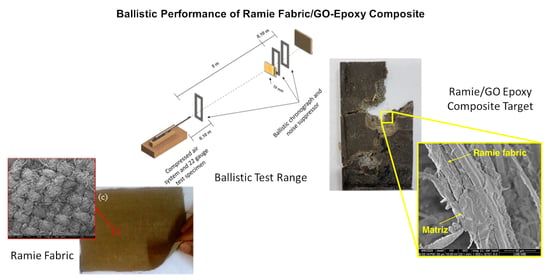Ballistic Performance of Ramie Fabric Reinforcing Graphene Oxide-Incorporated Epoxy Matrix Composite
Abstract
1. Introduction
2. Materials and Methods
2.1. Materials
2.2. Composite Processing
2.3. Ballistic Test
2.4. X-ray Diffraction
2.5. Fourier-Transform Infrared Spectroscopy (FTIR)
2.6. Thermal Analysis
2.7. Scanning Electron Microscope (SEM)
3. Results and Discussion
3.1. Ballistic Test
3.2. Thermogravimetric Analysis (TGA)
3.3. Fourier-Transform Infrared Spectroscopy (FTIR)
4. Summary and Conclusions
- In an unprecedented way, the ballistic performance of the composite with 0.5 vol % of GO in the epoxy matrix reinforced with 30 vol % of ramie fabric was evaluated and the composite characterized by thermal, FTIR and XRD analyses.
- Ballistic tests showed an increase in absorption energy. It was highlighted that the composite was tougher in the presence of GO in the epoxy matrix and increased the ballistic energy absorbed when compared to other composites.
- The images obtained by SEM revealed improvement in the fiber/matrix interface with the presence of GO. The pullout effect of the fibers in the matrix was not observed. In addition, the epoxy fracture surface showed roughness and separation of platelets that contributed to enhancing the mechanical properties.
- Thermal analyses by TG and DTG curves showed a degradation that starts at 343 °C with an 82% weight loss. In addition, the degradation peaks between 309 and 475 °C did not change in the presence of GO in the decomposition mechanism of the epoxy matrix. A working temperature of 300 °C may be assigned to this novel composite indicating higher thermal resistance than fiber composite usually applied in ballistic armors. Furthermore, DSC analysis demonstrated exothermic peaks at around 77 and 131 °C; and endothermic peaks during the cooling cycle at around 115 and 120 °C associated with the composite glass transition temperature.
- The FTIR pointed out the existence of OH to CH bands of the ramie fabric and the CO bands from the epoxy and GO. The presence of the same bands in the different samples in similar proportions of transmitted intensity may indicate that there was a good distribution of GO in epoxy resin composites reinforced with ramie fabric.
- The composite XRD diffractogram proved the tendency of the epoxy resin to reflect the GO characteristic peaks. The presence of the ramie fabric peaks was detected at approximately 28°.
- As compared with numerous natural fiber and fabric-reinforced polymer composites, the novel ramie fabric-reinforced GO-incorporated epoxy composite is a promising material for the second layer in a ceramic front multilayered ballistic armor for personal protection.
Author Contributions
Funding
Acknowledgments
Conflicts of Interest
References
- Zhang, H.; Jia, Z.; Feng, A.; Zhou, Z.; Zhang, C.; Wang, K.; Liu, N.; Wu, G. Enhanced microwave absorption performance of sulfur-doped hollow carbon microspheres with mesoporous shell as a broadband absorber. Compos. Commun. 2020, 19, 42–50. [Google Scholar] [CrossRef]
- Zhou, X.; Jia, Z.; Feng, A.; Qu, S.; Wang, X.; Liu, X.; Wang, B.; Wu, G. Synthesis of porous carbon embedded with NiCo/CoNiO2 hybrids composites for excellent electromagnetic wave absorption performance. J. Colloid Interface Sci. 2020, 575, 130–139. [Google Scholar] [CrossRef] [PubMed]
- Zhou, X.; Jia, Z.; Feng, A.; Kou, J.; Cao, H.; Liu, X.; Wu, G. Construction of multiple electromagnetic loss mechanism for enhanced electromagnetic absorption performance of fish scale-derived biomass absorber. Compos. Part B Eng. 2020, 192, 107980. [Google Scholar] [CrossRef]
- Luz, F.S.; Garcia Filho, F.C.; Del-Río, M.T.G.; Nascimento, L.F.C.; Pinheiro, W.A.; Monteiro, S.N. Graphene-Incorporated Natural Fiber Polymer Composites: A First Overview. Polymers 2020, 12, 1601. [Google Scholar] [CrossRef] [PubMed]
- Sarker, F.; Karim, N.; Afroj, S.; Koncherry, V.; Novoselov, K.S.; Potluri, P. High-Performance Graphene-Based Natural Fiber Composites. ACS Appl. Mater. Interfaces 2018, 10, 34502–34512. [Google Scholar] [CrossRef]
- Novoselov, K.S.; Fal’Ko, V.I.; Colombo, L.; Gellert, P.R.; Schwab, M.G.; Kim, K. A roadmap for graphene. Nature 2012, 490, 192–200. [Google Scholar] [CrossRef]
- Geim, A.K.; Novoselov, K.S. The rise of graphene. Nanosci. Technol. Collect. Rev. Nat. J. 2009, 11–19. [Google Scholar] [CrossRef]
- Dewapriya, M.A.N.; Meguid, S.A. Tailoring fracture strength of graphene. Comput. Mater. Sci. 2018, 141, 114–121. [Google Scholar] [CrossRef]
- Sainsbury, T.; Gnaniah, S.; Spencer, S.J.; Mignuzzi, S.; Belsey, N.A.; Paton, K.R.; Satti, A. Extreme mechanical reinforcement in graphene oxide based thin-film nanocomposites via covalently tailored nanofiller matrix compatibilization. Carbon N. Y. 2017, 114, 367–376. [Google Scholar] [CrossRef]
- Papageorgiou, D.G.; Kinloch, I.A.; Young, R.J. Mechanical properties of graphene and graphene-based nanocomposites. Prog. Mater. Sci. 2017, 90, 75–127. [Google Scholar] [CrossRef]
- Miculescu, M.; Thakur, V.K.; Miculescu, F.; Voicu, S.I. Graphene-based polymer nanocomposite membranes: A review. Polym. Adv. Technol. 2016, 27, 844–859. [Google Scholar] [CrossRef]
- Chen, J.; Huang, Z.; Lv, W.; Wang, C. Graphene Oxide Decorated Sisal Fiber/MAPP Modified PP Composites: Toward High-Performance Biocomposites. Polym. Compos. 2017, 16, 101–113. [Google Scholar] [CrossRef]
- Liu, L.; Zhang, J.; Zhao, J.; Liu, F. Mechanical properties of graphene oxides. Nanoscale 2012, 4, 5910–5916. [Google Scholar] [CrossRef] [PubMed]
- Zhang, H.; Jia, Z.; Feng, A.; Zhou, Z.; Chen, L.; Zhang, C.; Liu, X.; Wu, G. In situ deposition of pitaya-like Fe3O4@C magnetic microspheres on reduced graphene oxide nanosheets for electromagnetic wave absorber. Compos. Part B Eng. 2020, 199, 108261. [Google Scholar] [CrossRef]
- Jia, Z.; Gao, Z.; Kou, K.; Feng, A.; Zhang, C.; Xu, B.; Wu, G. Facile synthesis of hierarchical A-site cation deficiency perovskite LaxFeO3-y/RGO for high efficiency microwave absorption. Compos. Commun. 2020, 20, 100344. [Google Scholar] [CrossRef]
- Rourke, J.P.; Pandey, P.A.; Moore, J.J.; Bates, M.; Kinloch, I.A.; Young, R.J.; Wilson, N.R. The real graphene oxide revealed: Stripping the oxidative debris from the graphene-like sheets. Angew. Chem. Int. Ed. 2011, 50, 3173–3177. [Google Scholar] [CrossRef]
- Qi, X.; Pu, K.Y.; Li, H.; Zhou, X.; Wu, S.; Fan, Q.L.; Liu, B.; Boey, F.; Huang, W.; Zhang, H. Amphiphilic graphene composites. Angew. Chem. Int. Ed. 2010, 49, 9426–9429. [Google Scholar] [CrossRef]
- Hasan, K.M.F.; Horváth, P.G.; Alpár, T. Potential natural fiber polymeric nanobiocomposites: A review. Polymers 2020, 12, 1072. [Google Scholar] [CrossRef]
- Zhang, Z.; Cai, S.; Li, Y.; Wang, Z.; Long, Y.; Yu, T.; Shen, Y. High performances of plant fiber reinforced composites—A new insight from hierarchical microstructures. Compos. Sci. Technol. 2020, 194. [Google Scholar] [CrossRef]
- Monteiro, S.N.; Lopes, F.P.D.; Barbosa, A.P.; Bevitori, A.B.; Silva, I.L.A.; Costa, L.L. Natural lignocellulosic fibers as engineering materials-An overview. Metall. Mater. Trans. A Phys. Metall. Mater. Sci. 2011, 42, 2963–2974. [Google Scholar] [CrossRef]
- Sanjay, M.R.; Madhu, P.; Jawaid, M.; Senthamaraikannan, P.; Senthil, S.; Pradeep, S. Characterization and Properties of Natural Fiber Polymer Composites: A Comprehensive Review. J. Clean. Prod. 2018, 172, 566–581. [Google Scholar] [CrossRef]
- Pickering, K.L.; Efendy, M.G.A.; Le, T.M. A review of recent developments in natural fibre composites and their mechanical performance. Compos. Part A Appl. Sci. Manuf. 2016, 83, 98–112. [Google Scholar] [CrossRef]
- Güven, O.; Monteiro, S.N.; Moura, E.A.B.; Drelich, J.W. Re-Emerging Field of Lignocellulosic Fiber—Polymer Composites and Ionizing Radiation Technology in their Formulation. Polym. Rev. 2016, 56, 702–736. [Google Scholar] [CrossRef]
- Mohammed, L.; Ansari, M.N.M.; Pua, G.; Jawaid, M.; Islam, M.S. A Review on Natural Fiber Reinforced Polymer Composite and Its Applications. Int. J. Polym. Sci. 2015, 2015. [Google Scholar] [CrossRef]
- Faruk, O.; Bledzki, A.K.; Fink, H.P.; Sain, M. Progress report on natural fiber reinforced composites. Macromol. Mater. Eng. 2014, 299, 9–26. [Google Scholar] [CrossRef]
- Thakur, V.K.; Thakur, M.K.; Gupta, R.K. Review: Raw Natural Fiber-Based Polymer Composites. Int. J. Polym. Anal. Charact. 2014, 19, 256–271. [Google Scholar] [CrossRef]
- Shah, D.U. Developing plant fibre composites for structural applications by optimising composite parameters: A critical review. J. Mater. Sci. 2013, 48, 6083–6107. [Google Scholar] [CrossRef]
- Faruk, O.; Bledzki, A.K.; Fink, H.P.; Sain, M. Biocomposites reinforced with natural fibers: 2000–2010. Prog. Polym. Sci. 2012, 37, 1552–1596. [Google Scholar] [CrossRef]
- Potluri, R.; Chaitanya Krishna, N. Potential and Applications of Green Composites in Industrial Space. Mater. Today Proc. 2019, 22, 2041–2048. [Google Scholar] [CrossRef]
- Youssef, A.M.; El-Sayed, S.M. Bionanocomposites materials for food packaging applications: Concepts and future outlook. Carbohydr. Polym. 2018, 193, 19–27. [Google Scholar] [CrossRef]
- Benzait, Z.; Trabzon, L. A review of recent research on materials used in polymer–matrix composites for body armor application. J. Compos. Mater. 2018, 52, 3241–3263. [Google Scholar] [CrossRef]
- Dittenber, D.B.; Gangarao, H.V.S. Critical review of recent publications on use of natural composites in infrastructure. Compos. Part A Appl. Sci. Manuf. 2012, 43, 1419–1429. [Google Scholar] [CrossRef]
- Holbery, J.; Houston, D. Natural-fiber-reinforced polymer composites in automotive applications. JOM 2006, 58, 80–86. [Google Scholar] [CrossRef]
- Nayak, S.Y.; Sultan, M.T.H.; Shenoy, S.B.; Kini, C.R.; Samant, R.; Shah, A.U.M.; Amuthakkannan, P. Potential of Natural Fibers in Composites for Ballistic Applications–A Review. J. Nat. Fibers 2020, in press. [Google Scholar] [CrossRef]
- Garcia Filho, F.D.C.; Oliveira, M.S.; Pereira, A.C.; Nascimento, L.F.C.; Matheus, J.R.G.; Monteiro, S.N. Ballistic behavior of epoxy matrix composites reinforced with piassava fiber against high energy ammunition. J. Mater. Res. Technol. 2020, 9, 1734–1741. [Google Scholar] [CrossRef]
- Neuba, L.M.; Junio, R.F.P.; Ribeiro, M.P.; Souza, A.T.; Lima, E.S.; Garcia Filho, F.C.; Figueiredo, A.B.H.; Braga, F.O.; Azevedo, A.R.G.; Monteiro, S.N. Promising Mechanical, Thermal, and Ballistic Properties of Novel Epoxy Composites Reinforced with Cyperus malaccensis Sedge Fiber. Polymers 2020, 12, 1776. [Google Scholar] [CrossRef]
- Luz, F.S.; Garcia Filho, F.C.; Oliveira, M.S.; Nascimento, L.F.C.; Monteiro, S.N. Composites with Natural Fibers and Conventional Materials Applied in a Hard Armor: A Comparison. Polymers 2020, 12, 1920. [Google Scholar] [CrossRef]
- Simonassi, N.T.; Pereira, A.C.; Monteiro, S.N.; Margem, F.M.; Rodríguez, R.J.S.; De Deus, J.F.; Vieira, C.M.F.; Drelich, J. Reinforcement of polyester with renewable ramie fibers. Mater. Res. 2017, 20, 51–59. [Google Scholar] [CrossRef]
- Romanzini, D.; Junior, H.L.O.; Amico, S.C.; Zattera, A.J. Preparation and characterization of ramie-glass fiber reinforced polymer matrix hybrid composites. Mater. Res. 2012, 15, 415–420. [Google Scholar] [CrossRef]
- Shihong, L.; Benlian, Z.; Qiyun, Z.; Xianrong, B. A new kind of super-hybrid composite material for civil use-ramie fibre/Al. Composites 1994, 25, 225–228. [Google Scholar] [CrossRef]
- Choi, H.Y.; Lee, J.S. Effects of surface treatment of ramie fibers in a ramie/poly(lactic acid) composite. Fibers Polym. 2012, 13, 217–223. [Google Scholar] [CrossRef]
- Kumar, R.; Zhang, L. Aligned ramie fiber reinforced arylated soy protein composites with improved properties. Compos. Sci. Technol. 2009, 69, 555–560. [Google Scholar] [CrossRef]
- Müssig, J. Cotton fibre-reinforced thermosets versus ramie composites: A comparative study using petrochemical- and agro-based resins. J. Polym. Environ. 2008, 16, 94–102. [Google Scholar] [CrossRef]
- He, L.P.; Tian, Y.; Wang, L.L. Study on ramie fiber reinforced polypropylene composites (RF-PP) and its mechanical properties. Adv. Mater. Res. 2008, 41–42, 313–316. [Google Scholar] [CrossRef]
- Long, C.-G.; He, L.-P.; Zhong, Z.-H.; Chen, S.-G. Studies on the Polypropylene Composites Reinforced by Ramier Fiber and K2Ti6O13 Whisker. Res. Lett. Mater. Sci. 2007, 2007, 1–4. [Google Scholar] [CrossRef]
- Nam, S.; Netravali, A.N. Green composites. II. Environment-friendly, biodegradable composites using ramie fibers and soy protein concentrate (SPC) resin. Fibers Polym. 2006, 7, 380–388. [Google Scholar] [CrossRef]
- Lodha, P.; Netravali, A.N. Characterization of stearic acid modified soy protein isolate resin and ramie fiber reinforced “green” composites. Compos. Sci. Technol. 2005, 65, 1211–1225. [Google Scholar] [CrossRef]
- Paiva Júnior, C.Z.; De Carvalho, L.H.; Fonseca, V.M.; Monteiro, S.N.; D’Almeida, J.R.M. Analysis of the tensile strength of polyester/hybrid ramie-cotton fabric composites. Polym. Test. 2004, 23, 131–135. [Google Scholar] [CrossRef]
- Marsyahyo, E.; Jamasri; Rochardjo, H.S.B.; Soekrisno. Preliminary investigation on bulletproof panels made from ramie fiber reinforced composites for NIJ Level II, IIA, and IV. J. Ind. Text. 2009, 39, 13–26. [Google Scholar] [CrossRef]
- Braga, F.D.O.; Milanezi, T.L.; Monteiro, S.N.; Louro, L.H.L.; Gomes, A.V.; Lima, É.P. Ballistic comparison between epoxy-ramie and epoxy-aramid composites in Multilayered Armor Systems. J. Mater. Res. Technol. 2018, 7, 541–549. [Google Scholar] [CrossRef]
- Monteiro, S.N.; Milanezi, T.L.; Louro, L.H.L.; Lima, É.P.; Braga, F.O.; Gomes, A.V.; Drelich, J.W. Novel ballistic ramie fabric composite competing with KevlarTM fabric in multilayered armor. Mater. Des. 2016, 96, 263–269. [Google Scholar] [CrossRef]
- Costa, U.O.; Nascimento, L.F.C.; Garcia, J.M.; Monteiro, S.N.; da Luz, F.S.; Pinheiro, W.A.; da Costa Garcia Filho, F. Effect of graphene oxide coating on natural fiber composite for multilayered ballistic armor. Polymers 2019, 11, 1356. [Google Scholar] [CrossRef] [PubMed]
- Costa, U.O.; Fabio, L.; Nascimento, C.; Garcia, J.M.; Bruno, W.; Bezerra, A.; Filho, G.; Santos, F.; Pinheiro, W.A.; Monteiro, S.N. Mechanical properties of composites with graphene oxide functionalization of either epoxy matrix or curaua fiber reinforcement. J. Mater. Res. Technol. 2020, 9, 13390–13401. [Google Scholar] [CrossRef]
- Naveen, J.; Jawaid, M.; Zainudin, E.S.; Sultan, M.T.H.; Yahaya, R. Evaluation of ballistic performance of hybrid Kevlar®/Cocos nucifera sheath reinforced epoxy composites. J. Text. Inst. 2019, 110, 1179–1189. [Google Scholar] [CrossRef]
- Braga, F.O.; Bolzan, L.T.; Ramos, F.J.H.T.V.; Monteiro, S.N.; Lima, É.P., Jr.; Silva, L.C. Ballistic Efficiency of Multilayered Armor Systems with Sisal Fiber Polyester Composites. Mater. Res. 2017, 20, 767–774. [Google Scholar] [CrossRef]
- Sarker, F.; Potluri, P.; Afroj, S.; Koncherry, V.; Novoselov, K.S.; Karim, N. Ultrahigh Performance of Nanoengineered Graphene-Based Natural Jute Fiber Composites. ACS Appl. Mater. Interfaces 2019, 11, 21166–21176. [Google Scholar] [CrossRef] [PubMed]
- Riaz, S.; Park, S.J. Thermal and mechanical interfacial behaviors of graphene oxide-reinforced epoxy composites cured by thermal latent catalyst. Materials 2019, 12, 1354. [Google Scholar] [CrossRef]
- Wei, Y.; Hu, X.; Jiang, Q.; Sun, Z.; Wang, P.; Qiu, Y.; Liu, W. Influence of graphene oxide with different oxidation levels on the properties of epoxy composites. Compos. Sci. Technol. 2018, 161, 74–84. [Google Scholar] [CrossRef]
- Garcia Filho, F.C.; Luz, F.S.; Oliveira, M.S.; Pereira, A.C.; Costa, U.O.; Monteiro, S.N. Thermal behavior of graphene oxide-coated piassava fiber and their epoxy composites. J. Mater. Res. Technol. 2020, 9, 5343–5351. [Google Scholar] [CrossRef]
- Demosthenes, L.C.C.; Nascimento, L.F.C.; Monteiro, S.N.; Costa, U.O.; Garcia Filho, F.C.; Luz, F.S.; Oliveira, M.S.; Ramos, F.J.H.T.V.; Pereira, A.C.; Braga, F.O. Thermal and structural characterization of buriti fibers and their relevance in fabric reinforced composites. J. Mater. Res. Technol. 2020, 9, 115–123. [Google Scholar] [CrossRef]
- Pereira, A.L.; Banea, M.D.; Neto, J.S.S.; Cavalcanti, D.K.K. Mechanical and thermal characterization of natural intralaminar hybrid composites based on sisal. Polymers 2020, 12, 866. [Google Scholar] [CrossRef] [PubMed]
- Chozhan, C.K.; Alagar, M.; Sharmila, R.J.; Gnanasundaram, P. Thermo mechanical behaviour of unsaturated polyester toughened epoxy-clay hybrid nanocomposites. J. Polym. Res. 2007, 14, 319–328. [Google Scholar] [CrossRef]
- Abraham, E.; Deepa, B.; Pothan, L.A.; Jacob, M.; Thomas, S.; Cvelbar, U.; Anandjiwala, R. Extraction of nanocellulose fibrils from lignocellulosic fibres: A novel approach. Carbohydr. Polym. 2011, 86, 1468–1475. [Google Scholar] [CrossRef]
- Cheng, H.; Lin, J.; Su, Y.; Chen, D.; Zheng, X.; Zhu, H. Green synthesis of soluble graphene in organic solvent via simultaneous functionalization and reduction of graphene oxide with urushiol. Mater. Today Commun. 2020, 23, 100938. [Google Scholar] [CrossRef]
- Garside, P.; Wyeth, P. Identification of Cellulosic Fibres by FTIR Spectroscopy: Differentiation of Flax and Hemp by FTIR. Stud. Conserv. 2014, 51, 205–211. [Google Scholar] [CrossRef]
- González, M.G.; Cabanelas, J.C.; Baseolga, J. Applications of FTIR on Epoxy Resins-Identification, Monitoring the Curing Process, Phase Separation and Water Uptake. Infrared Spectrosc. Mater. Sci. Eng. Technol. 2012, 16, 208. [Google Scholar]
- Abdullah, S.I.; Ansari, M.N.M. Mechanical properties of graphene oxide (GO)/epoxy composites. HBRC J. 2015, 11, 151–156. [Google Scholar] [CrossRef]
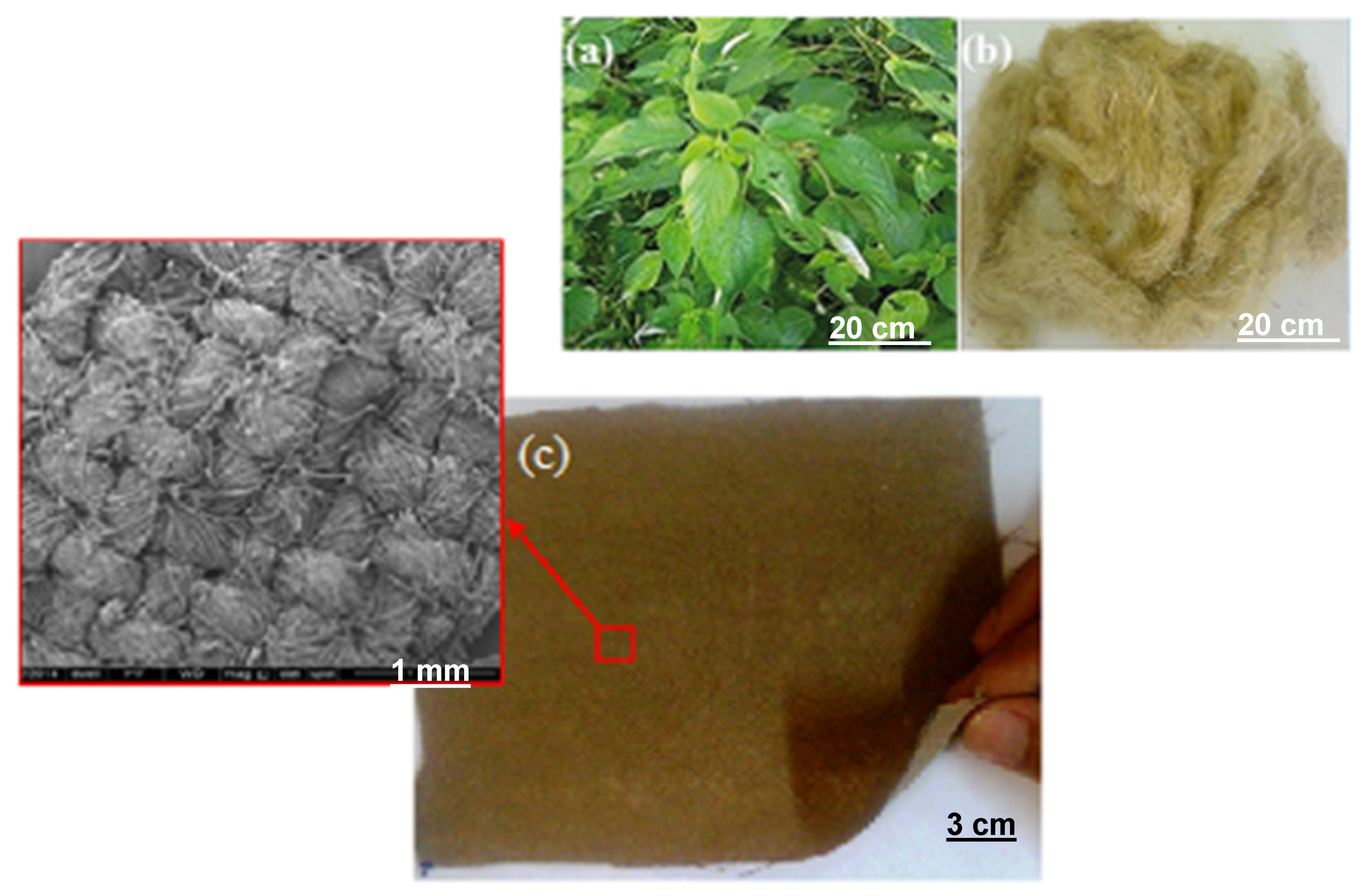

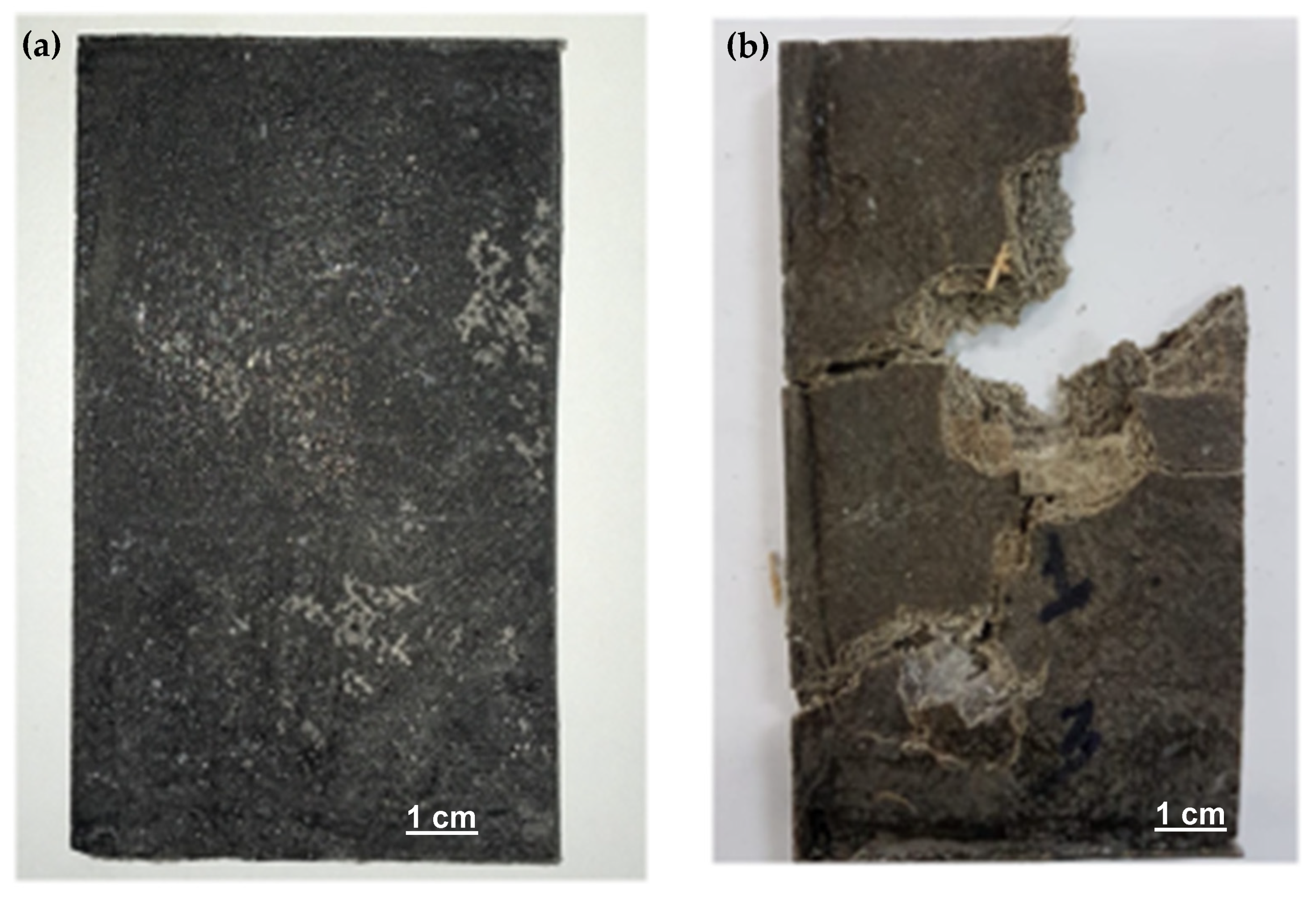
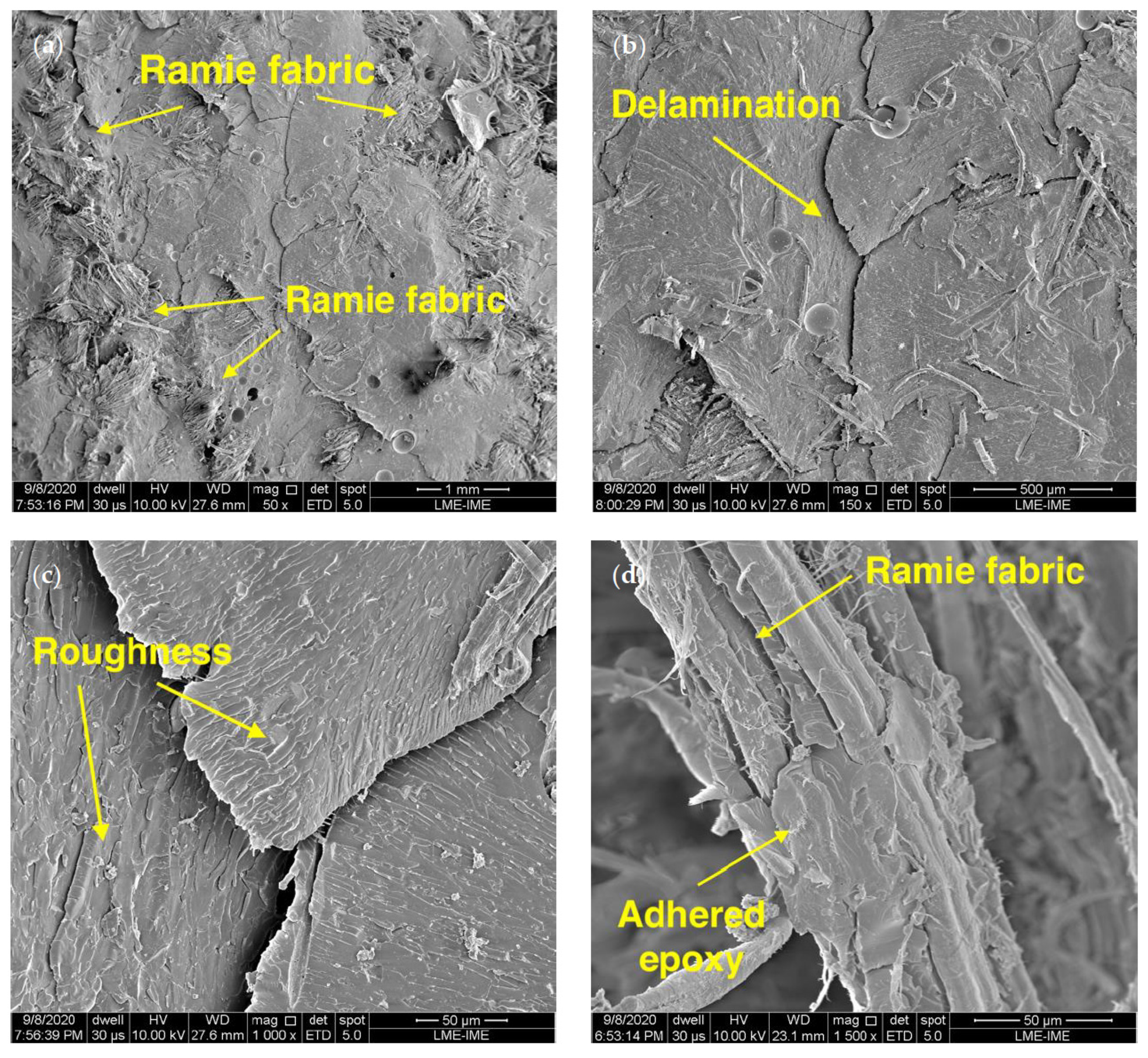
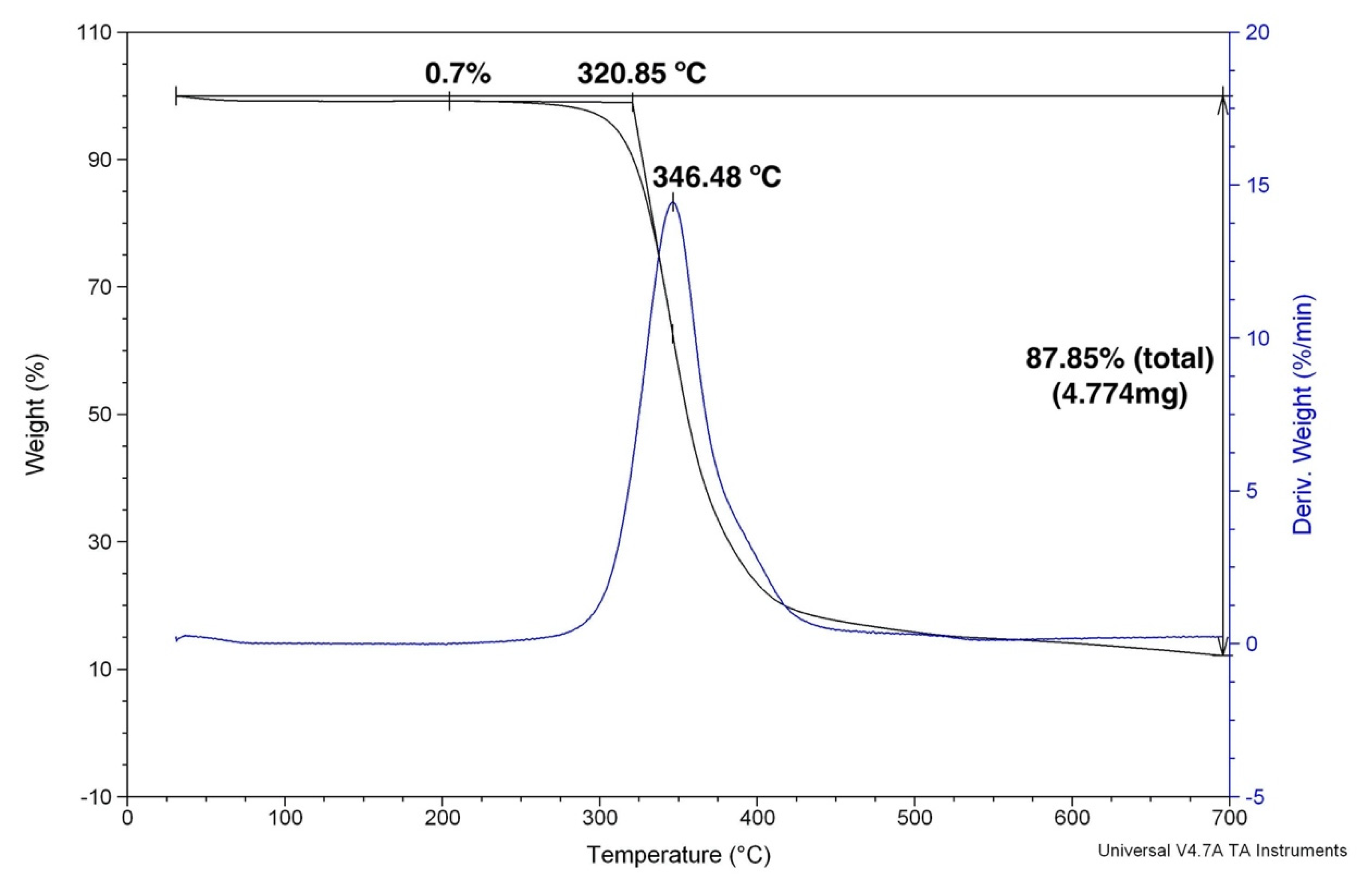


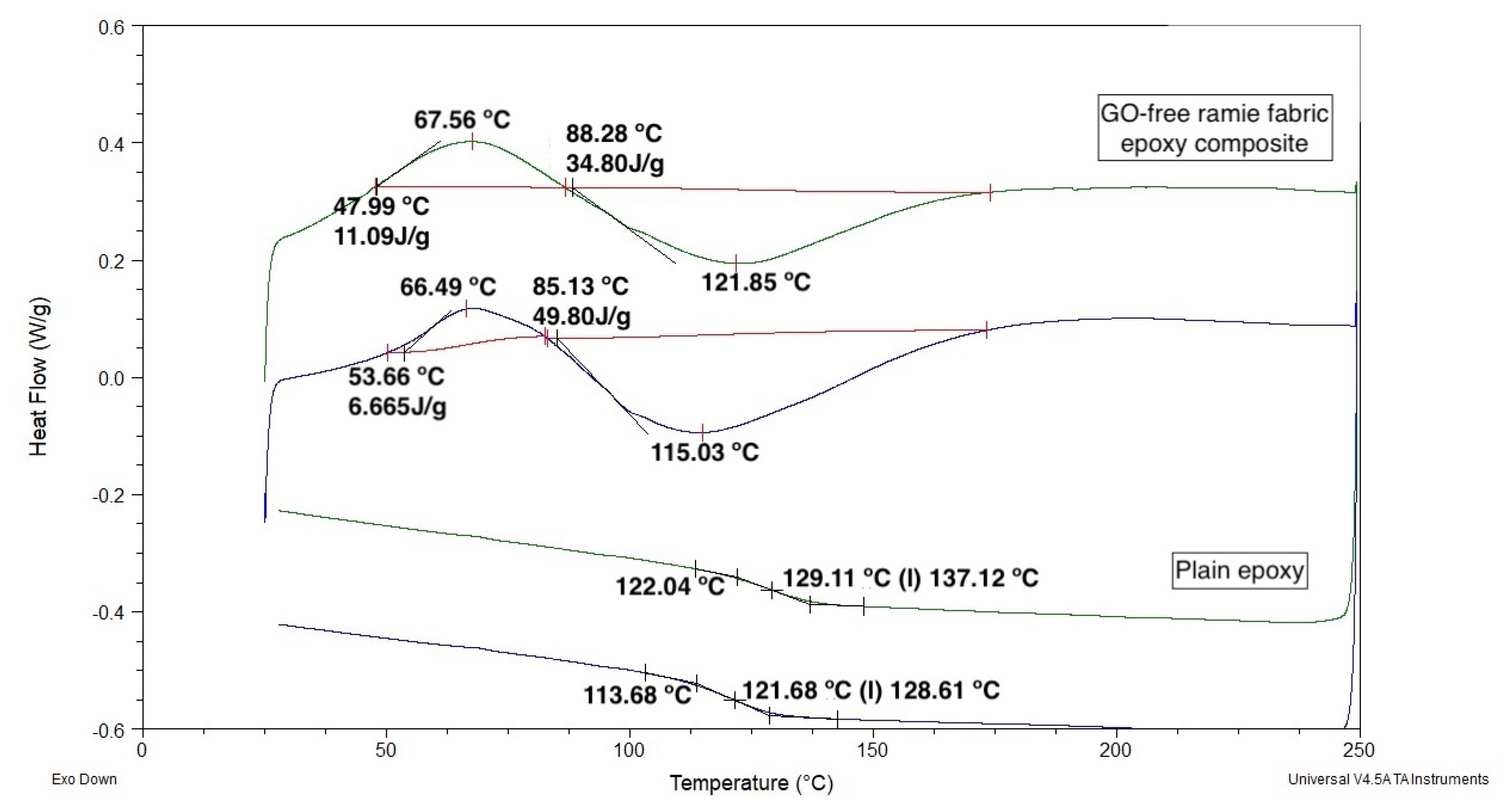

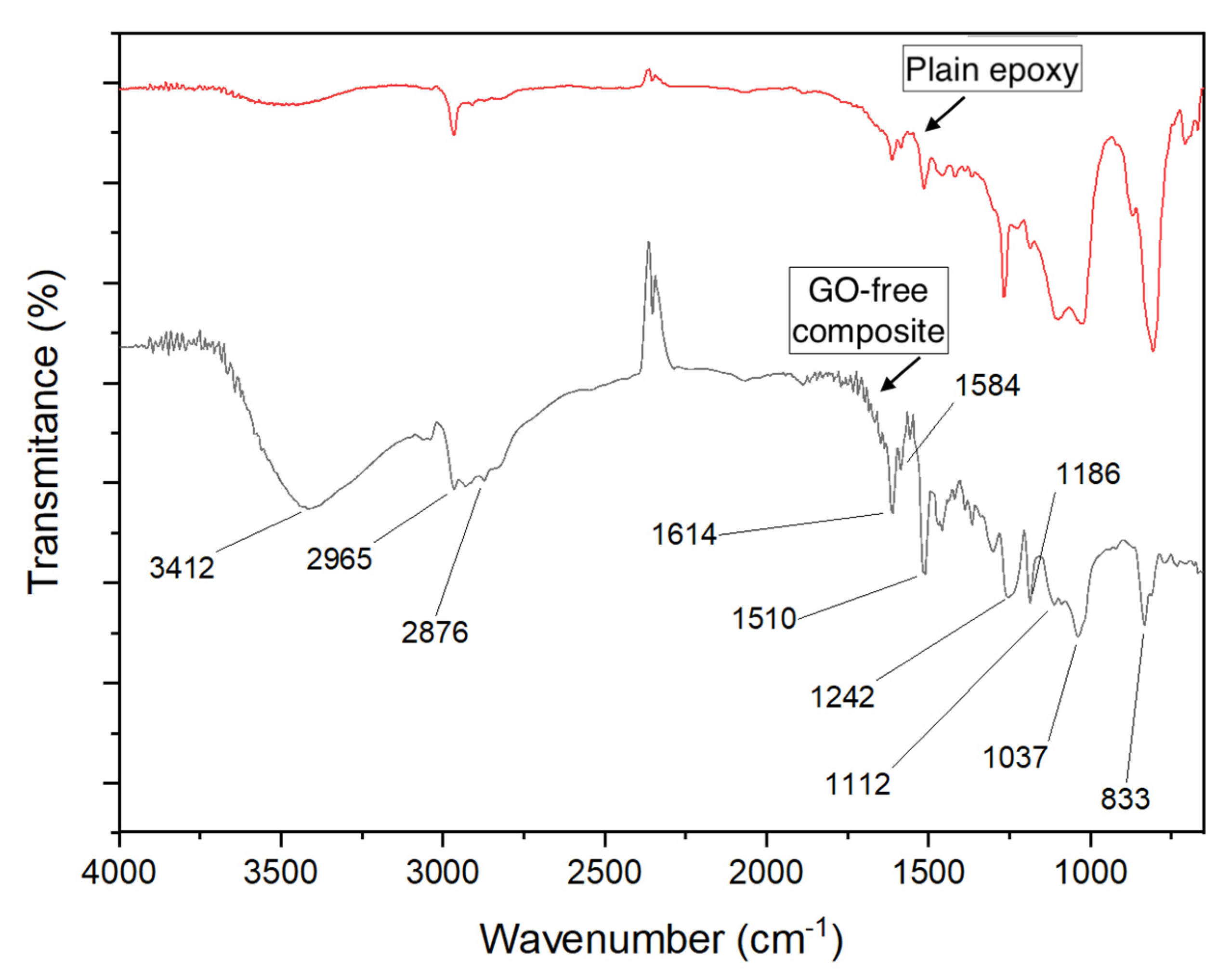

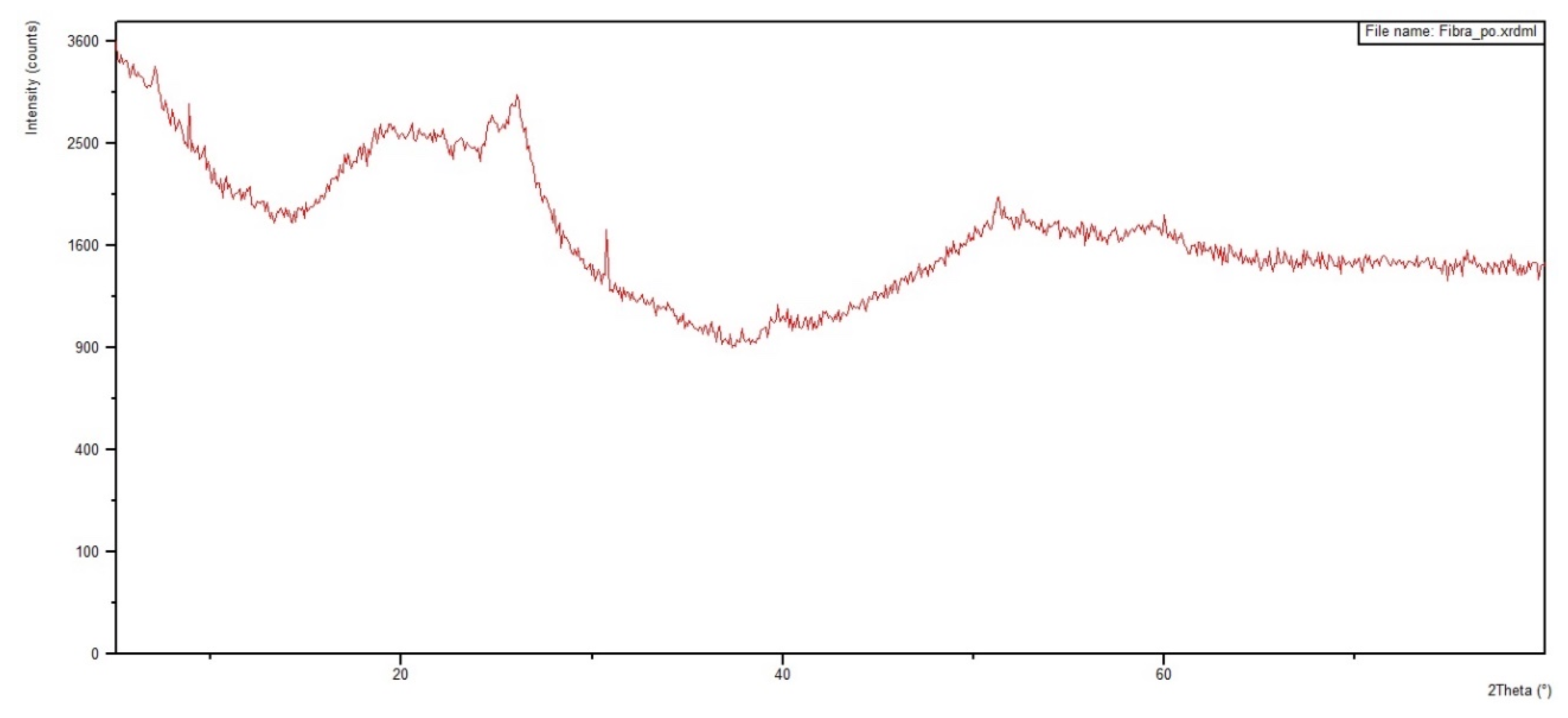
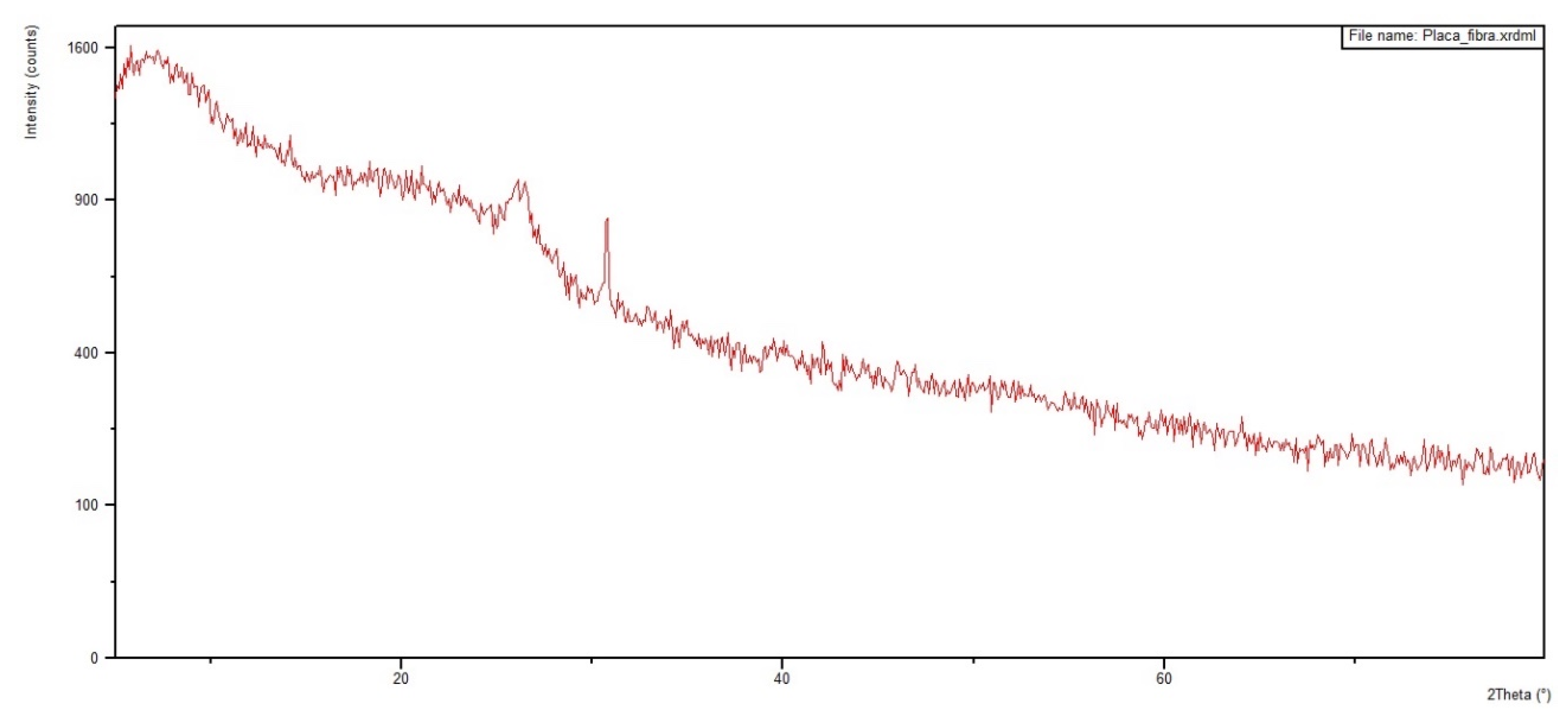
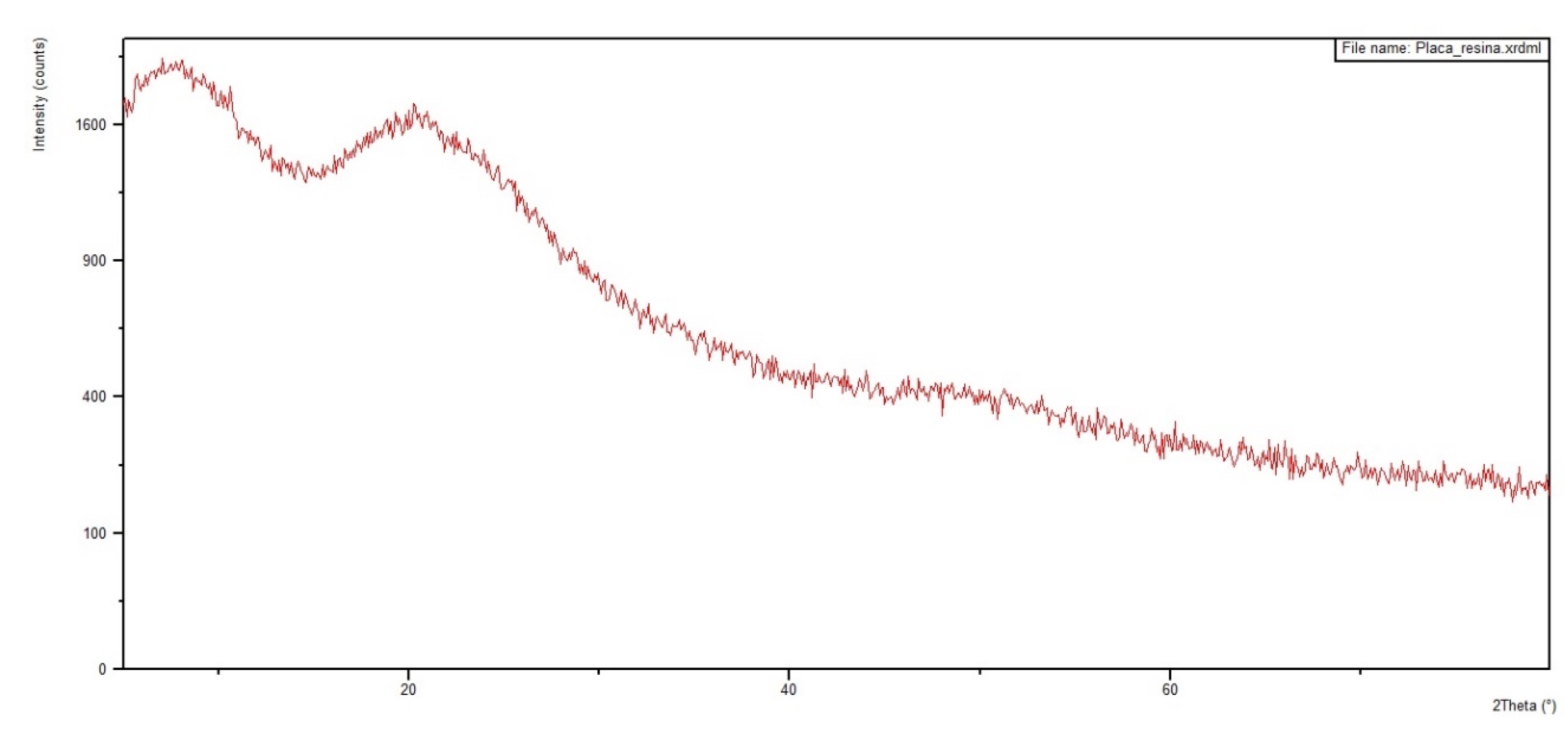
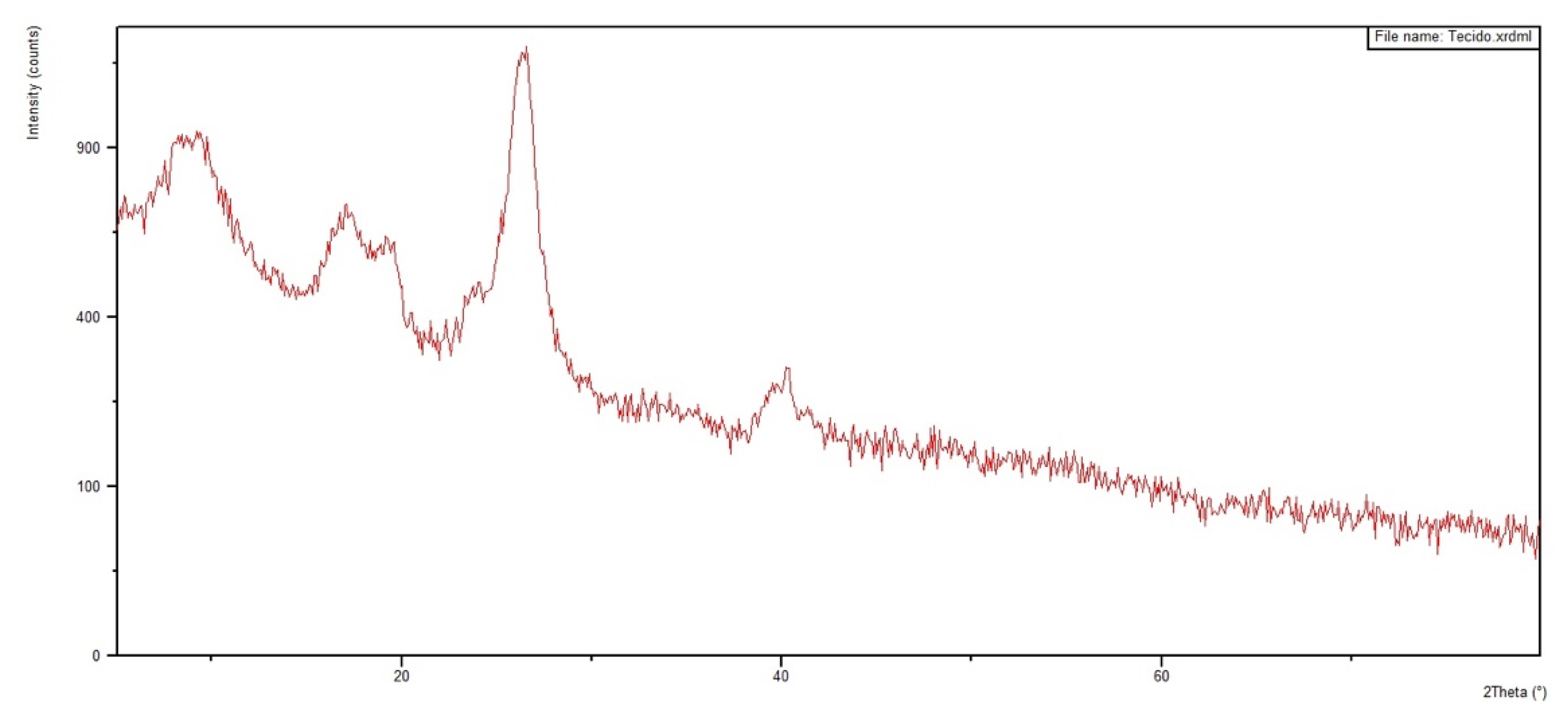
| Specimen | mp (g) | vi (m/s) | vr (m/s) | Eabs (J) |
|---|---|---|---|---|
| No target (E0) | 3.36 ± 0.05 | 285.83 ± 5.28 | 283.77 ± 2.38 | 2.69 ± 1.71 |
| Composite | 3.36 ± 0.03 | 283.23 ± 6.63 | 42.67 ± 32.10 | 130.34 ± 9.51 |
Publisher’s Note: MDPI stays neutral with regard to jurisdictional claims in published maps and institutional affiliations. |
© 2020 by the authors. Licensee MDPI, Basel, Switzerland. This article is an open access article distributed under the terms and conditions of the Creative Commons Attribution (CC BY) license (http://creativecommons.org/licenses/by/4.0/).
Share and Cite
Pereira, A.C.; Lima, A.M.; Demosthenes, L.C.d.C.; Oliveira, M.S.; Costa, U.O.; Bezerra, W.B.A.; Monteiro, S.N.; Rodriguez, R.J.S.; Deus, J.F.d.; Anacleto Pinheiro, W. Ballistic Performance of Ramie Fabric Reinforcing Graphene Oxide-Incorporated Epoxy Matrix Composite. Polymers 2020, 12, 2711. https://doi.org/10.3390/polym12112711
Pereira AC, Lima AM, Demosthenes LCdC, Oliveira MS, Costa UO, Bezerra WBA, Monteiro SN, Rodriguez RJS, Deus JFd, Anacleto Pinheiro W. Ballistic Performance of Ramie Fabric Reinforcing Graphene Oxide-Incorporated Epoxy Matrix Composite. Polymers. 2020; 12(11):2711. https://doi.org/10.3390/polym12112711
Chicago/Turabian StylePereira, Artur Camposo, Andreza Menezes Lima, Luana Cristyne da Cruz Demosthenes, Michelle Souza Oliveira, Ulisses Oliveira Costa, Wendell Bruno Almeida Bezerra, Sergio Neves Monteiro, Ruben Jesus Sanchez Rodriguez, Janine Feitosa de Deus, and Wagner Anacleto Pinheiro. 2020. "Ballistic Performance of Ramie Fabric Reinforcing Graphene Oxide-Incorporated Epoxy Matrix Composite" Polymers 12, no. 11: 2711. https://doi.org/10.3390/polym12112711
APA StylePereira, A. C., Lima, A. M., Demosthenes, L. C. d. C., Oliveira, M. S., Costa, U. O., Bezerra, W. B. A., Monteiro, S. N., Rodriguez, R. J. S., Deus, J. F. d., & Anacleto Pinheiro, W. (2020). Ballistic Performance of Ramie Fabric Reinforcing Graphene Oxide-Incorporated Epoxy Matrix Composite. Polymers, 12(11), 2711. https://doi.org/10.3390/polym12112711









